Flap and Wing Dynamics for a Light Sport Aircraft Analysis Using a Topological Model
Abstract
Featured Application
Abstract
1. Introduction
2. Graph Associated with a Planar Mechanism
2.1. The Kinematic Equivalent Mechanism and Associated Graph
- A beam element with several joints along its length can be considered a polygon, made by bars with joints at the corners (in Figure 3, triangles). For example, if on a line there are three collinear joints, this is equivalent to a triangle, with two angles measuring 0° and the third 180°.
- To connect different points where the joints connect to the ground (a fixed element), additional bar-type elements are introduced to obtain a polygon. Afterwards, one of these elements is removed. These newly introduced elements have zero angular velocities and angular accelerations.
2.2. Incidence Matrix
- if branch j is incident at node i and comes out of the node;
- if branch j is incident at node i and enters the node;
- if branch j is not incident at node i.
- ▪
- if the branch j is part of the loop i having a positive orientation;
- ▪
- if side j is part of the loop i having a negative orientation;
- ▪
- if branch j is not part of loop i.
3. Kinematic Analysis of the Control Mechanism
- partitioned in (matrix of the length of bar elements with an unknown motion) and (matrix of the length of bar elements with a known motion)
- , the matrix with the cosine of the angles made by the bars with the horizontal axis, partitioned in (unknown motion) and (known motion)
- , the matrix with the sine of the angles made by the bars with the horizontal axis, partitioned in (unknown motion) and (known motion)
4. Dynamic Analysis
5. Conclusions
Author Contributions
Funding
Institutional Review Board Statement
Informed Consent Statement
Data Availability Statement
Acknowledgments
Conflicts of Interest
Appendix A
References
- Chen, W.-K. Graph Theory and Its Engineering Applications; Advanced Electrical and Computer Engineering; World Scientific Publishing Company: Singapore, 1997; ISBN 978-9810218591. [Google Scholar]
- Deo, N. Graph Theory with Applications to Engineering and Computer Science, 1st ed.; Dover Books on Mathematics; Dover Publications: Mineola, NY, USA, 2016; ISBN 978-0486807935. [Google Scholar]
- Chen, W.-K. Applied Graph Theory: Graphs and Electrical Networks, Kindle ed.; North Holland: Amsterdam, The Netherlands, 2014. [Google Scholar]
- Sun, L.; Zhou, Y.Z.; Chen, X.; Wu, C.Y.; Zhang, G.F. Type Synthesis and Application of Gear Linkage Transplanting Mechanisms Based on Graph Theory. Trans. ASABE 2019, 62, 515–528. [Google Scholar] [CrossRef]
- Santiago-Valentin, E.; Portilla-Flores, E.A.; Mezura-Montes, E.; Vega-Alvarado, E.; Calva-Yáñez, M.B.; Pedroza-Villalba, M. Graph-Theory-Based Method for Topological and Dimensional Representation of Planar Mechanisms as a Computational Tool for Engineering Design. IEEE Access 2019, 7, 587–596. [Google Scholar] [CrossRef]
- Escalera, J.A.; Abu-Dakka, F.J.; Abderrahim, M. Symbolic Geometric Modeling of Tree-Structure Robotic Mechanisms Using Lie Groups and Graph Theory. Asian J. Control 2018, 20, 2088–2100. [Google Scholar] [CrossRef]
- Cao, W.Q.; Yan, T.H. Applications of Graph Theory in Mechanism Analysis. In Emerging Topics on Differential Geometry and Graph Theory; Mathematics Research Developments; Nova Science Publishers: New York, NY, USA, 2010; pp. 1–34. [Google Scholar]
- Kovalev, M.D. Structural Graphs of the Theory of Mechanisms. J. Mach. Manuf. Reliab. 2023, 52, 129–133. [Google Scholar] [CrossRef]
- Luo, J.G.; He, M.Y. Analysis on Degree of Freedom and Singularity of Mechanism Based on Topological Graph Theory. In Proceedings of the International Conference on Frontiers of Advanced Materials and Engineering Technology (FEMET 2012), Xiamen, China, 4–5 January 2012; Parts 1–3. Volume 430–432, pp. 1943–1946. [Google Scholar]
- Luo, J.G.; He, M.Y. Moving capability of mechanism based on topological graph theory. In Proceedings of the 2nd Annual International Conference on Electronics, Electrical Engineering and Information Science (EEEIS-2016), Xi’an, China, 2–4 December 2016; Volume 117, pp. 518–523. [Google Scholar]
- Luo, J.G.; Han, J.Y. Design and Analysis of Mechanism Based on Topological Theory. In Proceedings of the International Conference on Material Science and Application (ICMSA), Suzhou, China, 13–14 June 2015; Volume 3, pp. 636–643. [Google Scholar]
- Liu, T.S.; Chou, C.C. Type Synthesis of Vehicle Planar Suspension Mechanism using Graph-Theory. J. Mech. Des. 1993, 115, 652–657. [Google Scholar] [CrossRef]
- Kawamoto, A.; Bendsoe, M.P.; Sigmund, O. Planar articulated mechanism design by graph theoretical enumeration. Struct. Multidiscip. Optim. 2004, 27, 295–299. [Google Scholar] [CrossRef]
- Uyguroglu, M.; Demirel, H. Kinematic analysis of tendon-driven robotic mechanisms using oriented graphs. Acta Mech. 2006, 182, 265–277. [Google Scholar] [CrossRef]
- Vlase, S.; Ghitescu, I.M.; Paun, M. A Kinematical Analysis of the Flap and Wing Mechanism of a Light Sport Aircraft Using Topological Models. Symmetry 2021, 13, 1243. [Google Scholar] [CrossRef]
- Shai, O.; Preiss, K. Graph theory representations of engineering systems and their embedded knowledge. Artif. Intell. Eng. 1999, 13, 273–281. [Google Scholar] [CrossRef]
- Yan, H.S.; Chiu, Y.T. An algorithm for the construction of generalized kinematic chains. Mech. Mach. Theory 2013, 62, 75–98. [Google Scholar] [CrossRef]
- Feng, C.M.; Liu, T.S. A graph-theory approach to designing deployable mechanism of reflector antenna. Acta Astronaut. 2013, 87, 40–47. [Google Scholar] [CrossRef]
- Tsai, L.W.; Chen, D.Z.; Lin, T.W. Dynamic analysis of geared robotic mechanisms using graph theory. J. Mech. Des. 1998, 120, 240–244. [Google Scholar] [CrossRef]
- Vucina, D.; Freudenstein, F. An Application of Graph-Theory and Nonlinear-Programming to the Kinematic Synthesis of Mechanisms. Mech. Mach. Theory 1991, 26, 553–563. [Google Scholar] [CrossRef]
- Shai, O. The Canonical Form of All Planar Linkage Topologies. In Proceedings of the ASME International Design. Engineering Technical Conferences/Computers and Information in Engineering Conference, San Diego, CA, USA, 30 August–2 September 2009; Parts A and B. Volume 7, pp. 1285–1294. [Google Scholar]
- Sedlaczek, K.; Eberhard, P. Topology Optimization of Large Motion Rigid Body Mechanisms with Nonlinear Kinematics. J. Comput. Nonlinear Dyn. 2009, 4, 021011. [Google Scholar] [CrossRef]
- Muller, A. Kinematic topology and constraints of multi-loop linkages. Robotica 2018, 36, 1641–1663. [Google Scholar] [CrossRef]
- Yan, Q.; Zhang, J.J.; Li, B.; Zhou, L. Kinematic Analysis and Dynamic Optimization Simulation of a Novel Unpowered Exoskeleton with Parallel Topology. J. Robot. 2019, 2019, 2953830. [Google Scholar] [CrossRef]
- Jain, A. Multibody graph transformations and analysis. Nonlinear Dyn. 2012, 67, 2779–2797. [Google Scholar] [CrossRef][Green Version]
- Wu, Y.J.; Zhou, J.T. A hierarchical and interlamination graph self-attention mechanism-based knowledge graph reasoning architecture. Inf. Sci. 2025, 686, 121345. [Google Scholar] [CrossRef]
- Du, Q.L.; Fan, J.Z.; Zhao, J. Kinematic synthesis and mechanism design of a six-bar jumping leg for elastic energy storage and release based on dead points. Mech. Mach. Theory 2024, 202, 105777. [Google Scholar] [CrossRef]
- Che, Y.M.; Luo, W.S.; Li, Q.A. Kinematic analysis of adjusting mechanism of bamboo and wood-based special-shaped panels sucker based on graph theory and closed-loop vector method. J. Mech. Sci. Technol. 2024; early access. [Google Scholar] [CrossRef]
- Xia, Z.H.; Tian, C.X.; Zhang, D. The novel synthesis of origami-inspired mechanisms based on graph theory. Mech. Mach. Theory 2024, 192, 105547. [Google Scholar] [CrossRef]
- He, L.T.; Fang, H.R.; Zhang, D. Design of a class of reconfigurable hybrid mechanisms for large complex curved surface machining based on topological graph theory. Mech. Mach. Theory 2023, 190, 105461. [Google Scholar] [CrossRef]
- Nafeh, H.A.; Esmail, E.L.; Abdali, S.H. Automatic Structural Synthesis of Planetary Geared Mechanisms using Graph Theory. J. Appl. Comput. Mech. 2023, 9, 384–403. [Google Scholar]
- Marin, M.; Öchsner, A.; Bhatti, M.M. Some results in Moore-Gibson-Thompson thermoelasticity of dipolar bodies. ZAMM-J. Appl. Math. Mech. 2020, 100, e202000090. [Google Scholar] [CrossRef]
- Zhu, J.; Shi, C.; Fan, X.; Liu, R. Synthesis and Networking of Spaceborne Deployable Prismatic Antenna Mechanisms Based on Graph Theory. Int. J. Aerosp. Eng. 2024, 1–19. [Google Scholar] [CrossRef]
- McPhee, J.; Schmitke, C.; Redmond, S. Dynamic modelling of mechatronic multibody systems with symbolic computing and linear graph theory. Math. Comput. Model. Dyn.Syst. 2004, 10, 1–23. [Google Scholar] [CrossRef]
- Cui, R.J.; Guo, Z.H.; Zhu, S.S. Analysis and Design of Lower-Mobility Parallel Mechanism of Non-symmetrical Based on Variable Topology Theory. In Proceedings of the 2nd International Conference on Manufacturing Science and Engineering, Advanced Manufacturing Systems, London, UK, May 2011; Parts 1–3. Volume 201–203, pp. 1907–1913. [Google Scholar]
- Shieh, W.B.; Sun, F.; Chen, D.Z. On the Topological Representation and Compatibility of Variable Topology Mechanisms. In Proceedings of the ASME International Design Engineering Technical Conferences/Computers and Information in Engineering Conference, Montreal, QC, Canada, 15–18 August 2010; Parts A and B. Volume 7, pp. 1223–1230. [Google Scholar]
- Lu, Y.; Ye, N.J. Type synthesis of parallel mechanisms by utilizing sub-mechanisms and digital topological graphs. Mech. Mach. Theory 2017, 109, 39–50. [Google Scholar] [CrossRef]
- Guo, Z.H.; Wang, K.J.; Qi, H.L. Topological Design and Genetic Synthesis of the Variable Topology Parallel Mechanisms. In Proceedings of the International Conference on Reconfigurable Mechanisms and Robots, London, UK, 22–24 June 2009; pp. 197–204. [Google Scholar]
- Zhang, W.J.; Breteler, A.J.K. An approach to mechanism topology identification with consideration of design processes progression. Proc. Inst. Mech. Eng. Part C-J. Mech. Eng. Sci. 1997, 211, 175–183. [Google Scholar] [CrossRef]
- Negrean, I.; Crisan, A.V.; Vlase, S. A New Approach in Analytical Dynamics of Mechanical Systems. Symmetry 2020, 12, 95. [Google Scholar] [CrossRef]
- Yu, J.; Han, S.M.; Kim, Y.Y. Simultaneous Shape and Topology Optimization of Planar Linkage Mechanisms Based on the Spring-Connected Rigid Block Model. J. Mech. Des. 2020, 142, 011401. [Google Scholar] [CrossRef]
- Lu, Y.; Leinonen, T. Type synthesis of unified planar-spatial mechanisms by systematic linkage and topology matrix-graph technique. Mech. Mach. Theory 2005, 40, 1145–1163. [Google Scholar] [CrossRef]
- Zhan, J.Q.; Yan, J.K.; Liu, M. Optimal design of electro-thermo-mechanical microactuators considering minimum length scale constraints. Proc. Inst. Mech. Eng. Part C-J. Mech. Eng. Sci. 2024; early access. [Google Scholar] [CrossRef]
- Jia, Z.Y.; You, J.H.; Han, Z. Cooperative Cognitive Dynamic System in UAV Swarms: Reconfigurable Mechanism and Framework. IEEE Veh. Technol. Mag. 2024; early access. [Google Scholar] [CrossRef]
- Jiang, W.; Chen, X.D.; Hu, H.P. Vibration Calculation of Spatial Multibody Systems Based on Constraint-Topology Transformation. J. Mech. 2011, 27, 479–491. [Google Scholar] [CrossRef]
- Müller, A. Screw and Lie group theory in multibody kinematics. Motion representation and recursive kinematics of tree-topology systems. Multibody Syst. Dyn. 2018, 43, 37–70. [Google Scholar] [CrossRef]
- Vlase, S.; Marin, M.; Scutaru, M.L.; Munteanu, R. Coupled transverse and torsional vibrations in a mechanical system with two identical beams. AIP Adv. 2017, 7, 065301. [Google Scholar] [CrossRef]
- Codarcea-Munteanu, L.; Marin, M.; Vlase, S. The study of vibrations in the context of porous micropolar media thermoelasticity and the absence of energy dissipation. J. Comput. Appl. Mech. 2023, 54, 437–454. [Google Scholar] [CrossRef]
- Vlase, S.; Teodorescu, P.P.; Itu, C.; Scutaru, M.L. Double Cardan Joint. Rom. J. Phys. 2013, 58, 882–892. [Google Scholar]
- Zhao, Q.; Wu, H.T.; Zhou, M.H. Generalized Mass Metric and Recursive Momentum Formulation for Dynamics of Multibody Systems. In Proceedings of the ASME International Design Engineering Technical Conferences/Computers and Information in Engineering Conference, Montreal, QC, Canada, 15–18 August 2010; Parts A–C. Volume 4, pp. 505–515. [Google Scholar]
- Tromme, E.; Sonneville, V.; Duysinx, P. On the equivalent static load method for flexible multibody systems described with a nonlinear finite element formalism. Int. J. Numer. Methods Eng. 2016, 108, 646–664. [Google Scholar] [CrossRef]
- Vlase, S.; Itu, C.; Marin, M.; Luminta Scutaru, M.; Sabou, F.; Necula, R. Vibration analysis of the Gamma-Ray element in the ELI-NP interaction chamber (IC). J. Comput. Appl. Mech. 2024, 55, 275–288. [Google Scholar] [CrossRef]
- Thulasiraman, K. Graphs: Theory and Algorithms; Wiley-Interscience: Hoboken, NJ, USA, 1992. [Google Scholar]
- EASA. Certification Specification and Acceptable Means of Compliance for Light Sport Aeroplanes, CS-LSA; European Aviation Safety Agency: Cologne, Germany, 2013. [Google Scholar]
- Gudmundsson, S. General Aviation Aircraft Design—Methods and Procedures, 1st ed.; Elsevier Inc.: Oxford, UK, 2014. [Google Scholar]
- Roskam, J. Airplane Design, Part I. Preliminary Sizing of Airplanes; University of Kansas: Lawrence, KS, USA, 1985. [Google Scholar]
- Zipfel, P.H. Modeling and Simulation of Aerospace Vehicle Dynamics, Revised Edition; AIAA: Las Vegas, NV, USA, 2014. [Google Scholar]
- Kroes, M.J.; Rardon, J.R.; Nolan, M.S. Aircraft Basic Science, 8th ed.; Mac Graw Hill: New York, NY, USA, 2013. [Google Scholar]
- Abzug, M.J. Airplane Stability and Control, 2nd ed.; Cambridge University Press: Cambridge, UK, 2008. [Google Scholar]
- Stanciu, M.D.; Vlase, S.; Marin, M. Vibration Analysis of a Guitar considered as a Symmetrical Mechanical System. Symmetry 2019, 11, 727. [Google Scholar] [CrossRef]
- Scutaru, M.L.; Vlase, S.; Marin, M.; Modrea, A. New analytical method based on dynamic response of planar mechanical elastic systems. Bound. Value Probl. 2020, 2020, 104. [Google Scholar] [CrossRef]
- Marin, M.; Chirila, A.; Ochsner, A.; Vlase, S. About finite energy solutions in thermoelasticity of micropolar bodies with voids. Bound. Value Probl. 2019, 2019, 89. [Google Scholar] [CrossRef]
- Vlase, S.; Negrean, I.; Marin, M.; Scutaru, M.L. Energy of Accelerations Used to Obtain the Motion Equations of a Three- Dimensional Finite Element. Symmetry 2020, 12, 321. [Google Scholar] [CrossRef]
- Zhou, C.; Zhang, R.; Wang, C. Flap-control mechanism for flapping-wing micro air vehicles. Proc. Inst. Mech. Eng. Part G-J. Aerosp. Eng. 2019, 233, 1537–1545. [Google Scholar] [CrossRef]
- Isbitirici, A.; Altug, E. Design and Control of a Mini Aerial Vehicle that has Four Flapping-Wings. J. Intell. Robot. Syst. 2017, 88, 247–265. [Google Scholar] [CrossRef]
- Huang, Y.; Nitsche, M.; Kanso, E. Stability versus maneuverability in hovering flight. Phys. Fluids 2015, 27, 061706. [Google Scholar] [CrossRef]
- Li, W.; He, G.Y.; Shi, J. The Design and Research Based on Spatial Crank-rocker Mechanism of Flapping Micro Air Vehicle. In Proceedings of the International Conference on Mechanical Science and Mechanical Design, MSMD 2015, Changsha, China, 12–13 December 2015; pp. 182–187. [Google Scholar]


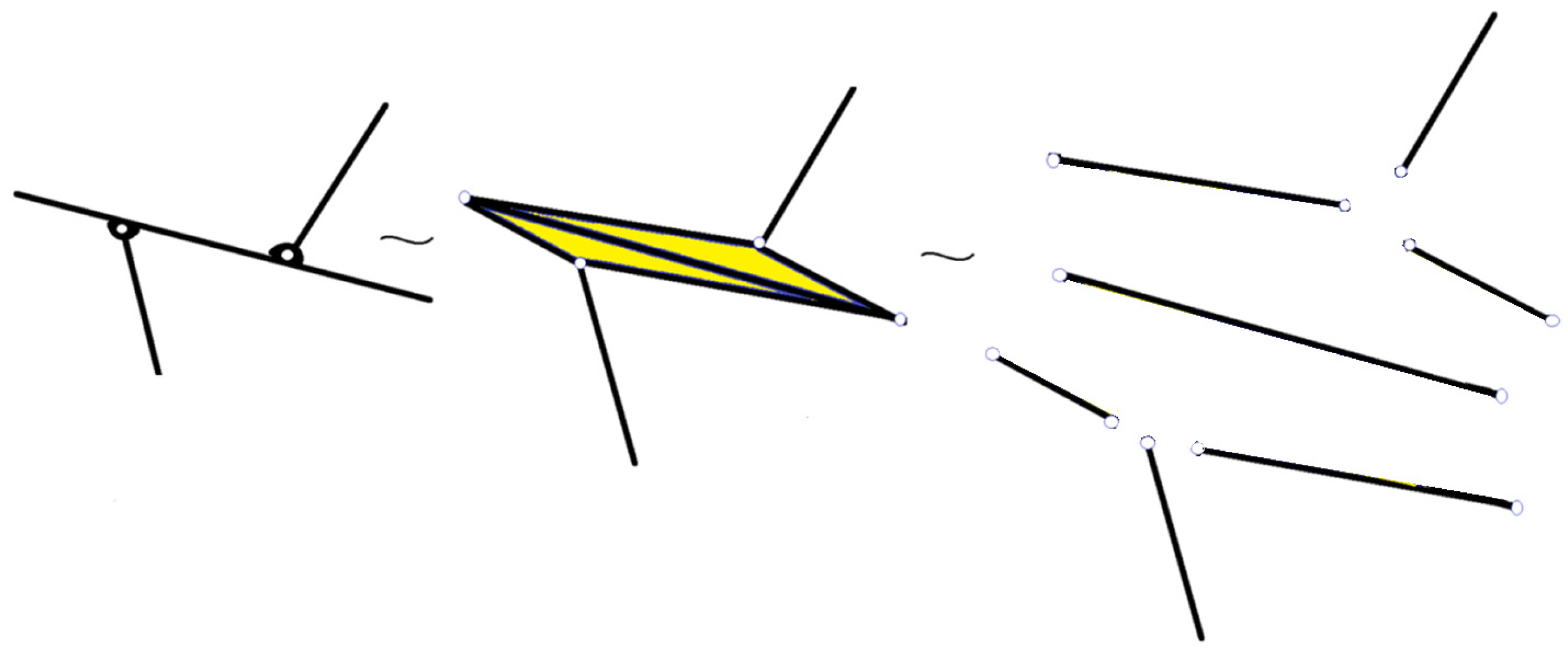
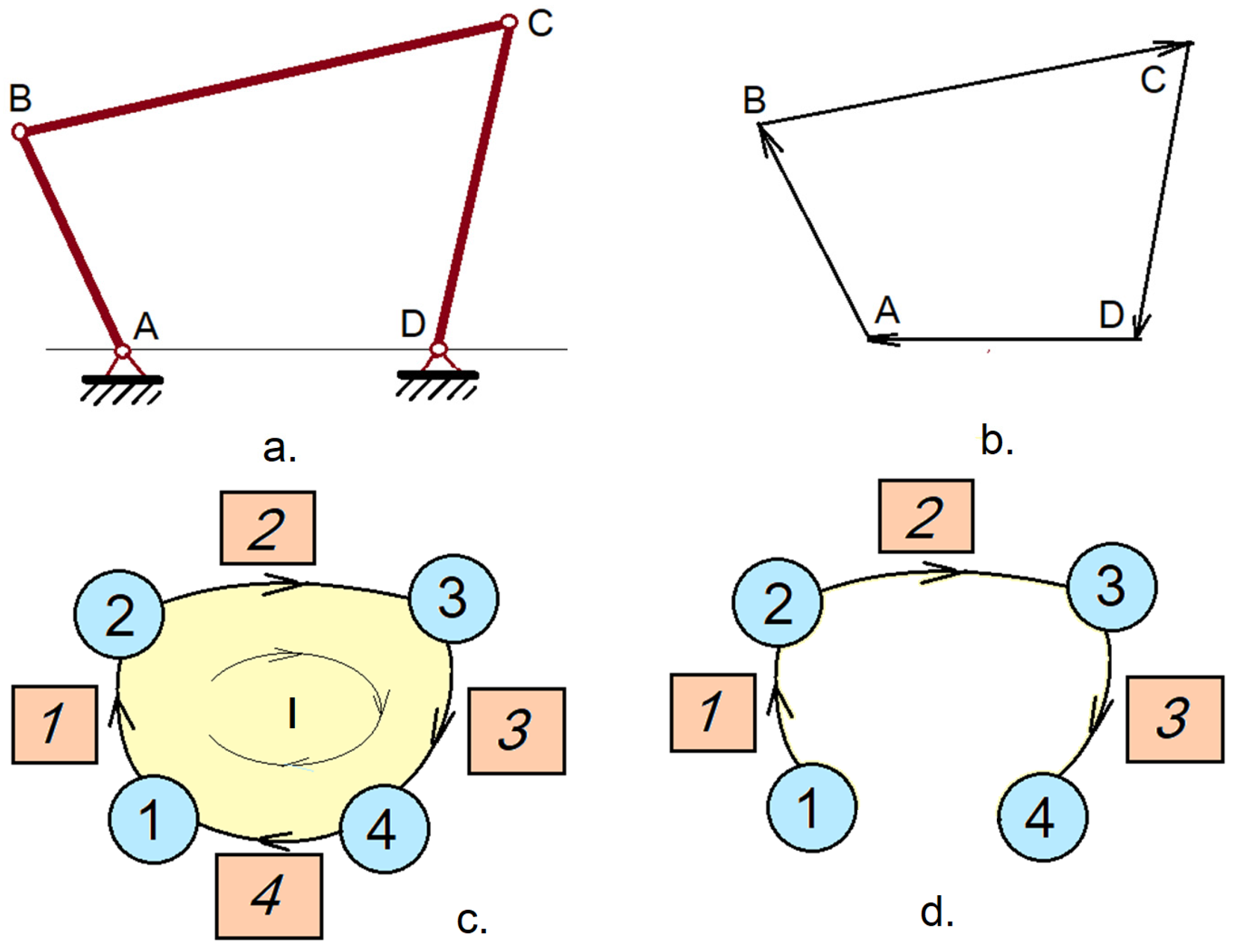
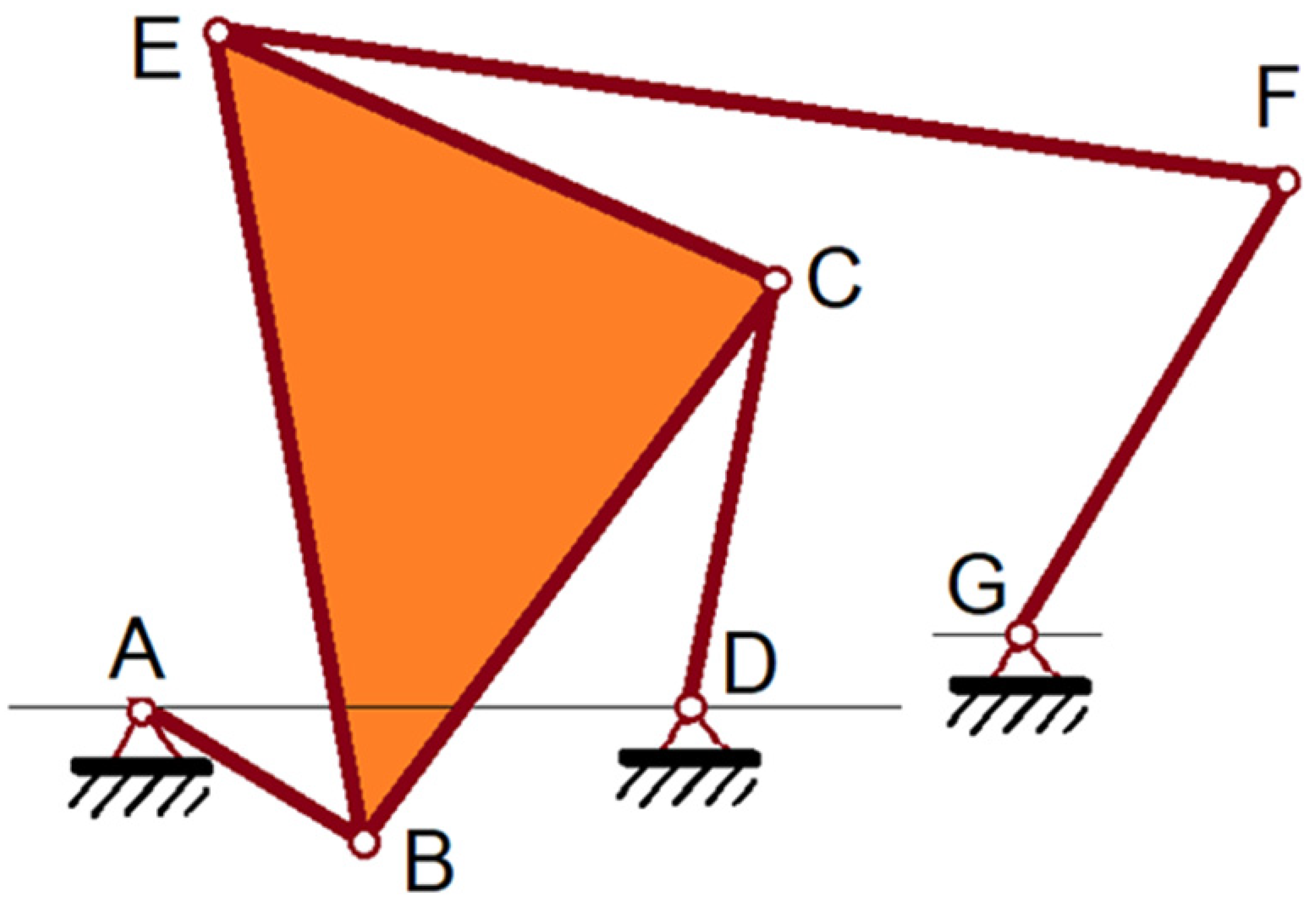

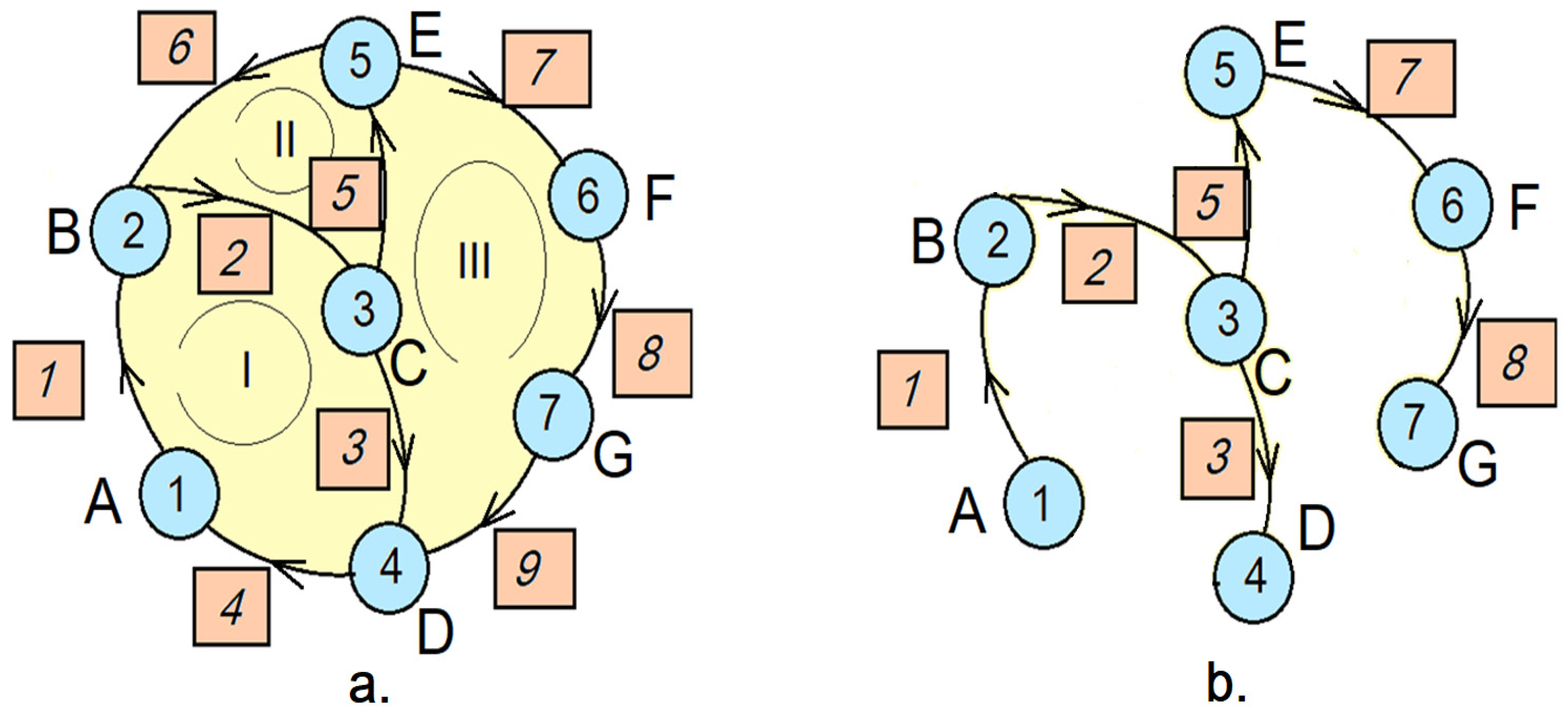


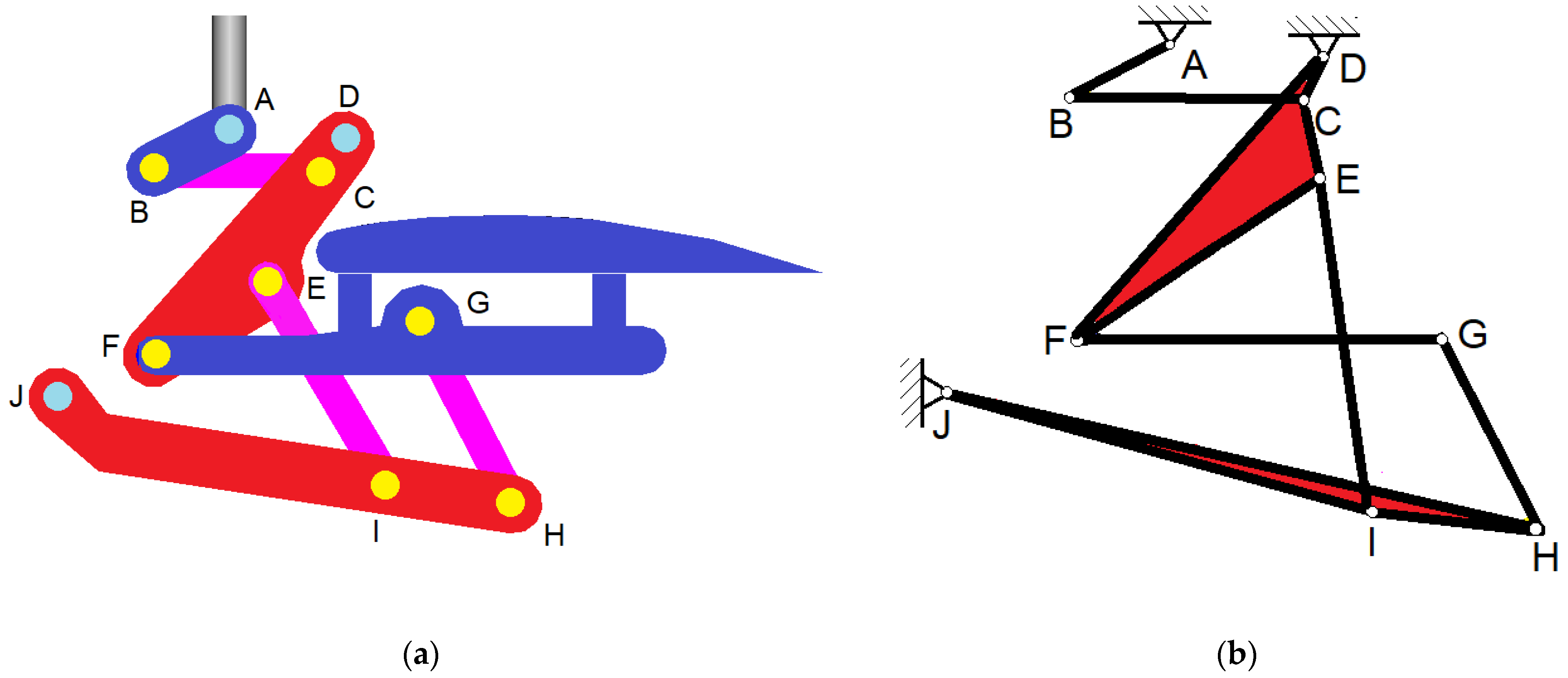

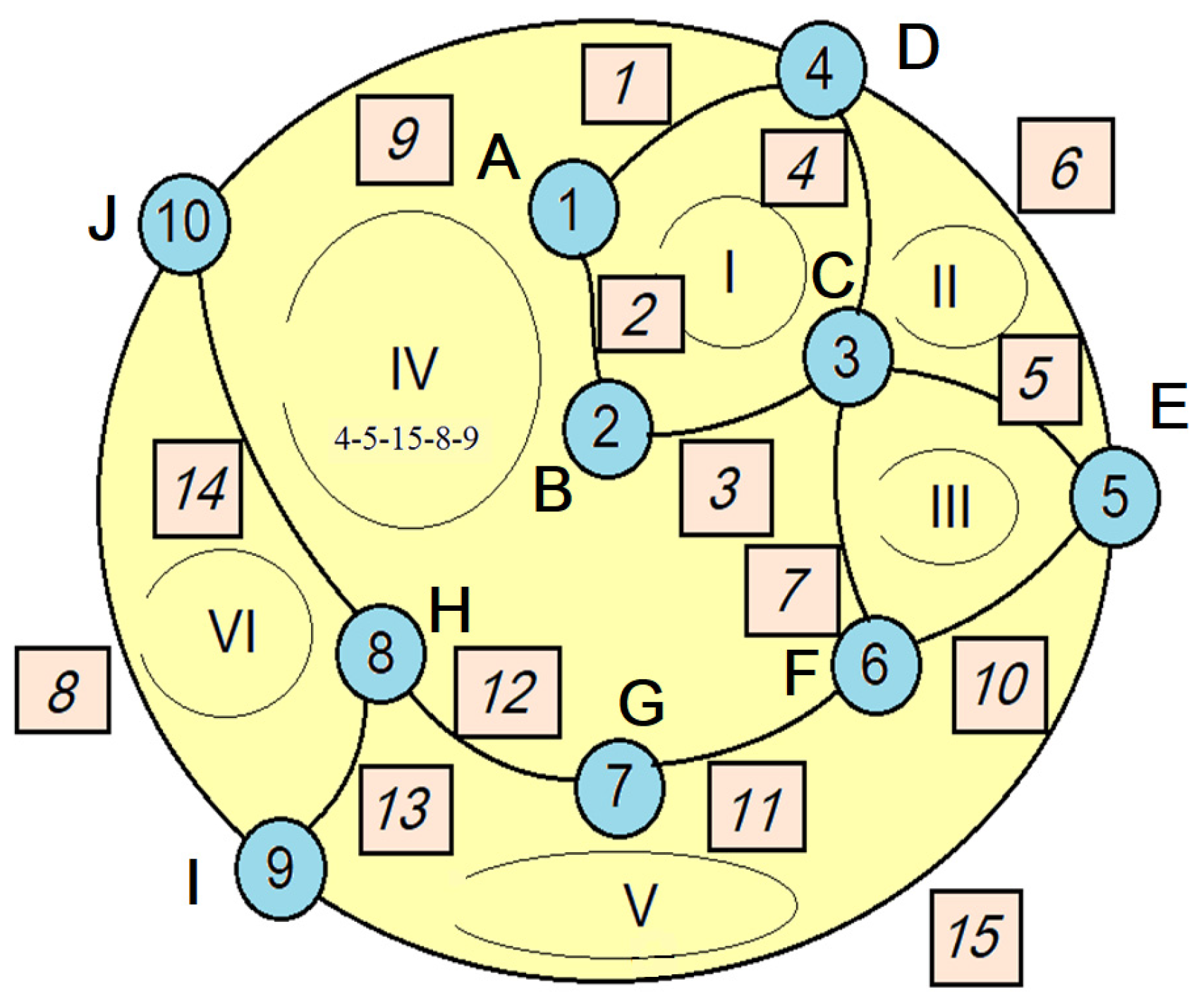

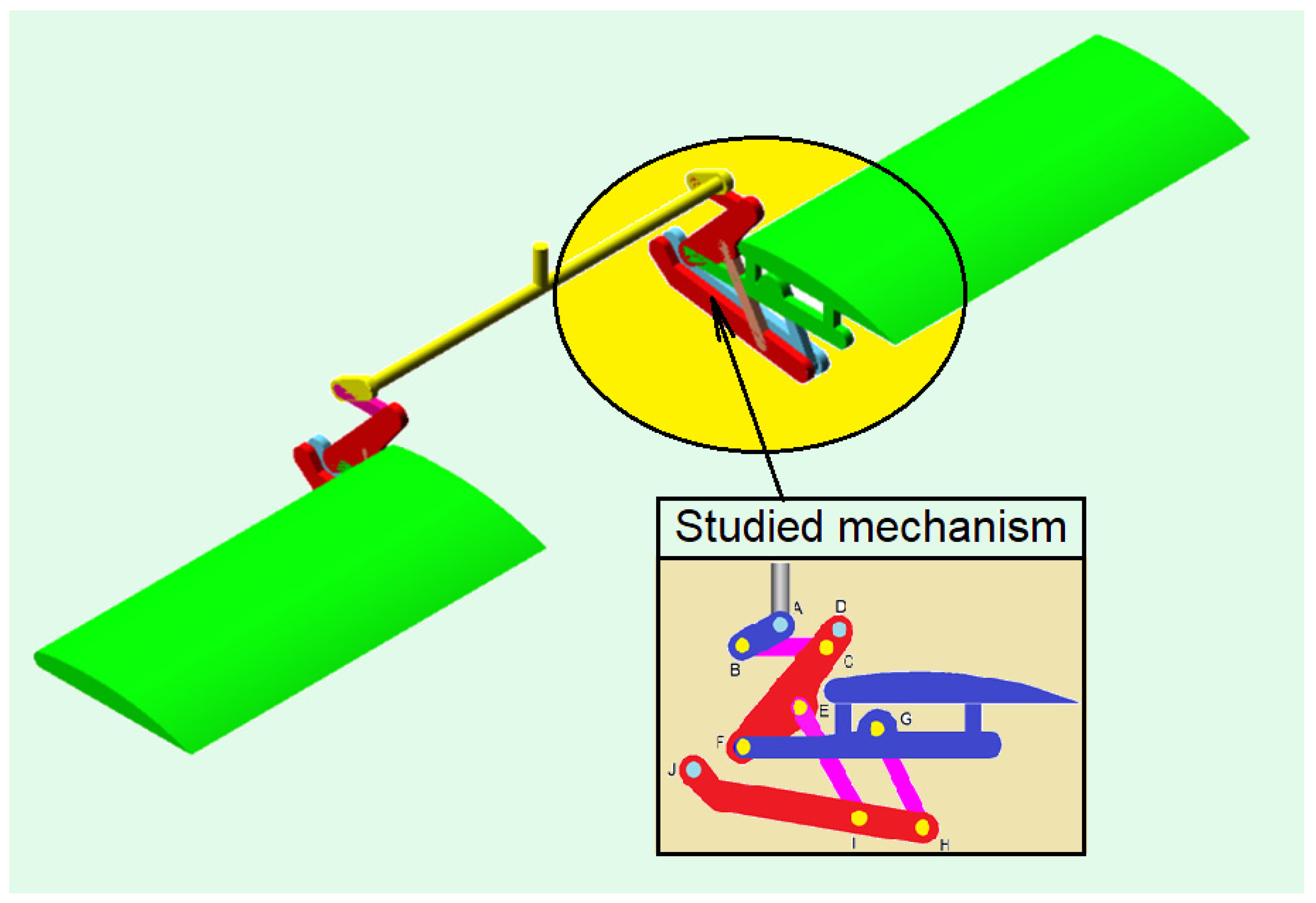
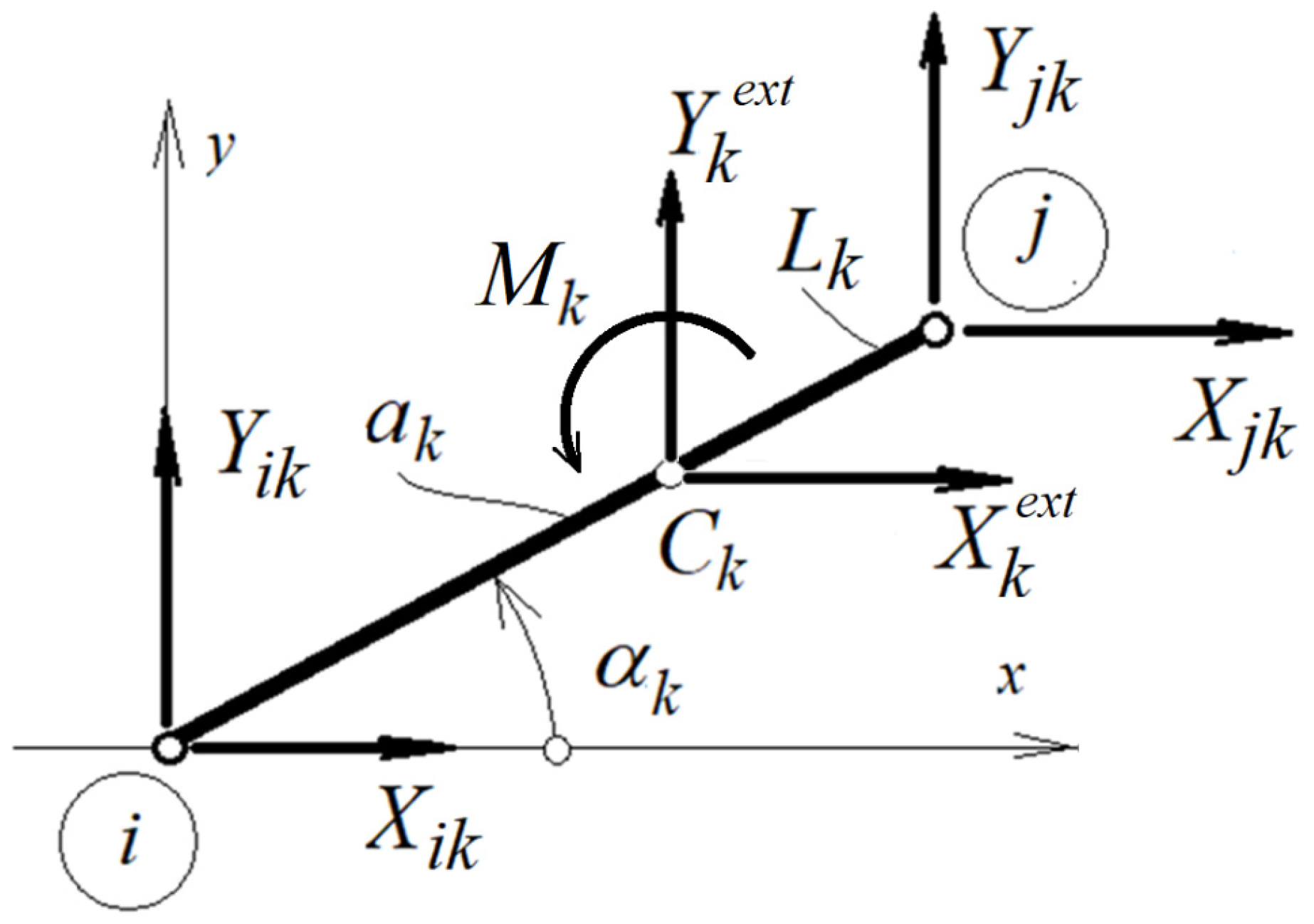
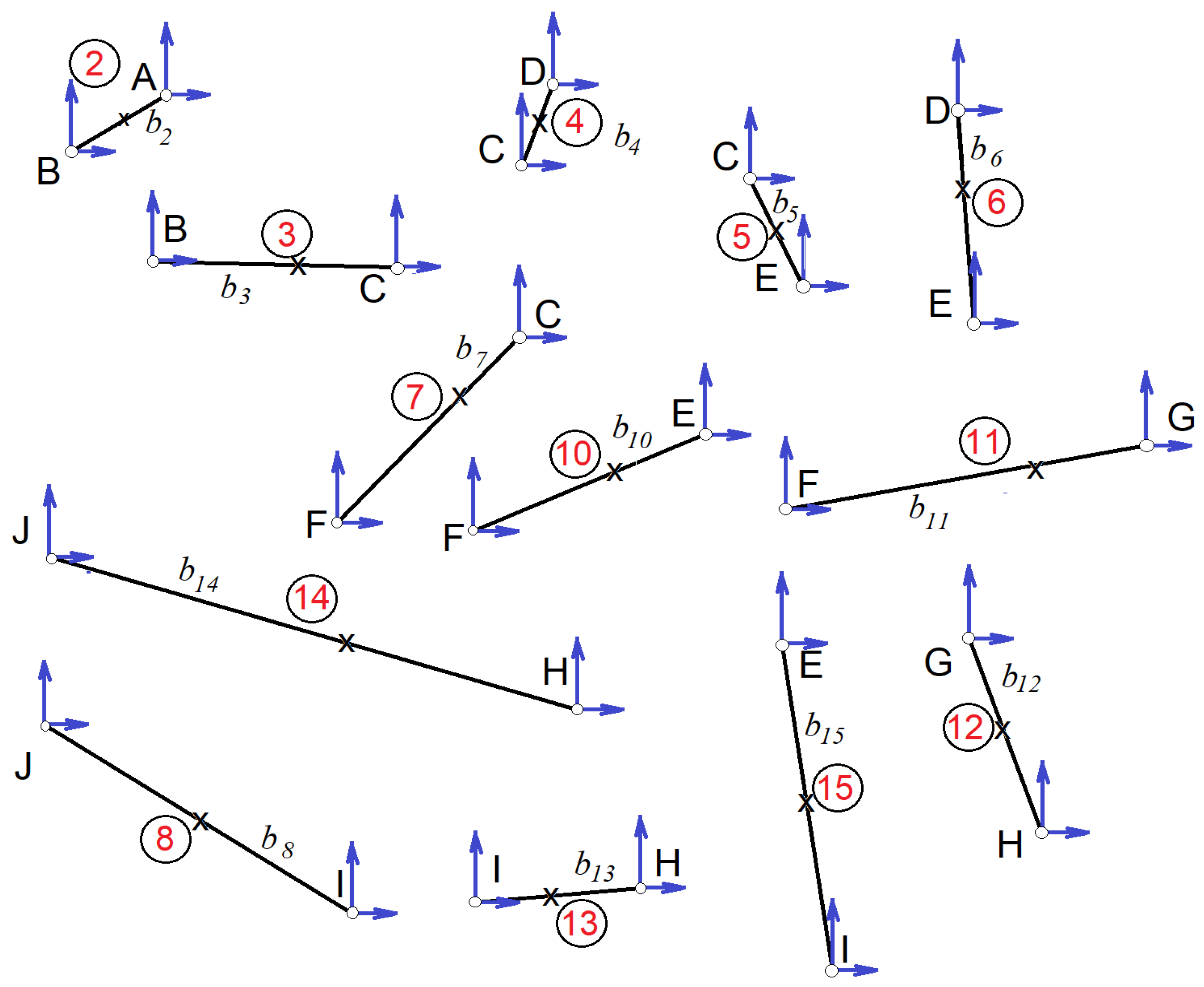
Disclaimer/Publisher’s Note: The statements, opinions and data contained in all publications are solely those of the individual author(s) and contributor(s) and not of MDPI and/or the editor(s). MDPI and/or the editor(s) disclaim responsibility for any injury to people or property resulting from any ideas, methods, instructions or products referred to in the content. |
© 2024 by the authors. Licensee MDPI, Basel, Switzerland. This article is an open access article distributed under the terms and conditions of the Creative Commons Attribution (CC BY) license (https://creativecommons.org/licenses/by/4.0/).
Share and Cite
Scutaru, M.L.; Vlase, S.; Marin, M. Flap and Wing Dynamics for a Light Sport Aircraft Analysis Using a Topological Model. Appl. Sci. 2024, 14, 8531. https://doi.org/10.3390/app14188531
Scutaru ML, Vlase S, Marin M. Flap and Wing Dynamics for a Light Sport Aircraft Analysis Using a Topological Model. Applied Sciences. 2024; 14(18):8531. https://doi.org/10.3390/app14188531
Chicago/Turabian StyleScutaru, Maria Luminita, Sorin Vlase, and Marin Marin. 2024. "Flap and Wing Dynamics for a Light Sport Aircraft Analysis Using a Topological Model" Applied Sciences 14, no. 18: 8531. https://doi.org/10.3390/app14188531
APA StyleScutaru, M. L., Vlase, S., & Marin, M. (2024). Flap and Wing Dynamics for a Light Sport Aircraft Analysis Using a Topological Model. Applied Sciences, 14(18), 8531. https://doi.org/10.3390/app14188531







